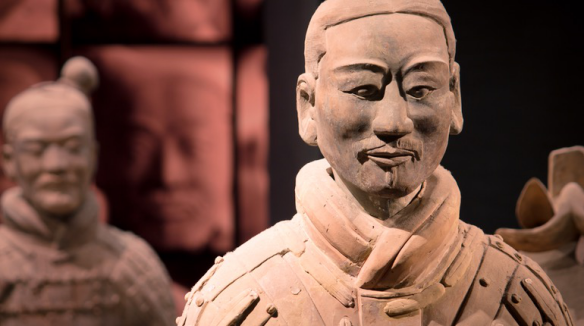
The Terracotta Army isn't just Xi'an's premier sight, it's one of the most famous archaeological finds in the world. This subterranean life-size army of thousands has silently stood guard over the soul of China's first unifier for more than two millennia. Either Qin Shi Huang was terrified of the vanquished spirits awaiting him in the afterlife, or as most archaeologists believe, he expected his rule to continue in death as it had in life.
Whatever the case, the guardians of his tomb today offer some of the greatest insights we have into the world of ancient China.
The discovery of the army of warriors was entirely fortuitous. In 1974, peasants drilling a well uncovered an underground vault that eventually yielded thousands of terracotta soldiers and horses in battle formation. Throughout the years the site became so famous that many of its unusual attributes are now well known, in particular the fact that no two soldier's faces are alike.
The on-site wrap-around theatre gives a useful primer on how the figures were sculpted. You can also employ a guide (low/high season ¥150/200) or try the audio guide (¥40, plus ¥200 deposit), although the latter is somewhat useless, being difficult to understand and not very compelling.
Then visit the site in reverse, which enables you to build up to the most impressive pit for a fitting finale.
Start with the smallest pit, Pit 3, containing 72 warriors and horses; it's believed to be the army headquarters due to the number of high-ranking officers unearthed here. It's interesting to note that the northern room would have been used to make sacrificial offerings before battle. In the next pit, Pit 2, containing around 1300 warriors and horses, you can examine five of the soldiers up close: a kneeling archer, a standing archer, a cavalryman and his horse, a mid-ranking officer and a general. The level of detail is extraordinary: the expressions, hairstyles, armour and even the tread on the footwear are all unique.
The largest pit, Pit 1, is the most imposing. Housed in a building the size of an aircraft hangar, it is believed to contain 6000 warriors (only 2000 are on display) and horses, all facing east and ready for battle. The vanguard of three rows of archers (both crossbow and longbow) is followed by the main force of soldiers, who originally held spears, swords, dagger-axes and other long-shaft weapons. The infantry were accompanied by 35 chariots, though these, made of wood, have long since disintegrated.
Almost as extraordinary as the soldiers is a pair of bronze chariots and horses unearthed just 20m west of the Tomb of Qin Shi Huang. These are now on display, together with some of the original weaponry and a mid-ranking officer you can see up close in a huge modern museum called the Qin Shi Huang Emperor Tomb Artifact Exhibition Hall.
You can take photographs, although signs forbid using flash photography (widely ignored) or tripods (also ignored by some).
Among rather tacky souvenir offerings, you can get your own warrior statue personalised with your own face (¥100) or have a photo taken next to a fake warrior (¥10). You can also pick up all manner of terracotta ornamentation – from warrior paperweights to life-size statues – from the souvenir shop in the theatre building. There's also a Friendship Store for jade, jewellery and so forth.
TIPS
1. Basic info
Address: Linlan Road, Lintong District, Xi’an
Ticket: Peak Season (March 1st ~ November 30th): CNY 150;
Off Season (December 1st ~ February 28th): CNY 120
Opening Time: March 16th ~ November 14th: 8:30~17:30
November 15th ~ March 15th: 8:30~17:00
2. Transportation
How to get to Terracotta Warriors from Xian Xianyang International Airport
Visitors can take Airport Shuttle Line 2 to Xian Railway Station. The bus departs every one hour from 10:15 to 19:15 at 1F of T2 and the ticket costs CNY 25.At the east square of the railway station,take tourism bus no.5 (306), 914, or 915, and get off at the final station.
Visitors can also hire a taxi from the airport. Remember to take the legitimate green colored taxies and the fee is about CNY 200.
How to getto Terracotta Armyfrom Xian Railway Stationor downtown
Go to theeast squareofthe railway stationto take tourism bus No.5 (306). It takes one hour and the fare is CNY7 per person.
One canalso take bus 307, which departs from Tangchengqiang Jiuqu Hub and passes Tang Paradise, Big Wild Goose Pagoda, Banpo Museum Bus Hub, and Huaqing Hot Spring. The whole journey takes 2.5 hours and costs CNY8per person.
How to get to Terracotta Army from Xi'an North Railway Station
There are free shuttle buses between North Railway Station and the museum. They are scheduled from the railway station from 8:00 to 16:00 andreturn buses from the museumrunfrom 10:30to 19:30. The whole journey takes aboutone hour.
Note: To take the free shuttle bus, you will get a boardingpass byshowing your train ticket on the arrival day and the entrance ticket to any attraction of Lintong. Upon arrival at the North Railway Station, you can buy the tickets of Lintong attractions at the Tourist Service Center on the underground floor.
From Lintong District:
Take bus 914, 915, or Speical Line 101, and get off at Terracotta Warriors Museum.
Inside Traffic:
30 free shuttle buses are traveling between the Museum of Qin Terracotta Warriors and Horses and the Qin Shi Huang Mausoleumfor tourists' convenience. One can take them by showing the entrance ticket of the museum.
Operating hours: 8:30-18:30
